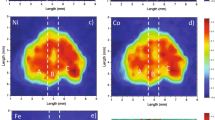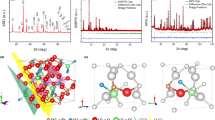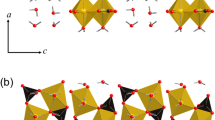Abstract
Calcium fluoride (CaF2), like the important UO2 phase, is a defect system having the remarkable property that large concentrations of trivalent rare-earth dopants can be accommodated within its structure with no loss of structural integrity. Using extended X-ray absorption fine structure (EXAFS), we have observed the way in which the local structural environment of the impurity alters with the size of the rare-earth ion and can distinguish, by computer lattice simulation studies, between dimer and hexamer configurations for light and heavy dopants, respectively.
This is a preview of subscription content, access via your institution
Access options
Subscribe to this journal
Receive 51 print issues and online access
$199.00 per year
only $3.90 per issue
Buy this article
- Purchase on Springer Link
- Instant access to full article PDF
Prices may be subject to local taxes which are calculated during checkout
Similar content being viewed by others
References
EXAFS for Inorganic Systems (Daresbury Laboratory Rep. DL/SCI/R17, 1981).
Bianconi, A., Incoccia, L. & Stipcich, S. (eds) EXAFS and Near Edge Structure (Springer, Berlin, 1983).
Tallant, D. R. & Wright, J. C. J. chem. Phys. 63, 2074–2085 (1975).
Moore, S. & Wright, J. C. J. chem. Phys. 74, 1626–1635 (1981).
Catlow, C. R. A., Chadwick, A. V. & Corish, J. J. Solid State Chem. 48, 65–76 (1983).
Catlow, C. R. A., Chadwick, A. V. & Corish, J. Radiation Effects 75, 61–72 (1983).
Corish, J., Catlow, C. R. A., Jacobs, P. W. M. & Ong, S. H. Phys. Rev. B25, 6425–6438 (1982).
Bendall, P. J., Catlow, C. R. A., Corish, J. & Jacobs, P. W. M. J. Solid State Chem. 51, 159–169 (1984).
Cheetham, A. K., Fender, B. E. F. & Cooper, M. J. Phys. C 4, 3107–3121 (1971).
Bevan, D. J. M., Greis, O. & Strahle, J. Acta crystallogr. A36, 889–890 (1980).
Bevan, D. J. M., Strahle, J. & Greis, O. J. Solid State Chem. 44, 75–81 (1982).
Stern, E. A., Sayers, D. E. & Lytle, F. W. Phys. Rev. B 11, 4836–4846 (1975).
Gurman, S. J. & Pendry, J. B. Solid State Commun. 20, 287–290 (1976).
Lee, P. A. & Pendry, J. B. Phys. Rev. B 100, 2795–2811 (1975).
Gurman, S. J., Binsted, N. & Ross, I. J. Phys. C 17, 143–152 (1984).
Lee, P. A., Citrin, P. H., Eisenberger, P. & Kincaid, B. M. Rev. mod. Phys. 53, 769–806 (1981).
Figueroa, D. R., Chadwick, A. V. & Strange, J. H. J. Phys. C 11, 55–73 (1978).
Author information
Authors and Affiliations
Rights and permissions
About this article
Cite this article
Catlow, C., Chadwick, A., Greaves, G. et al. Direct observations of the dopant environment in fluorites using EXAFS. Nature 312, 601–604 (1984). https://doi.org/10.1038/312601a0
Received:
Accepted:
Issue Date:
DOI: https://doi.org/10.1038/312601a0
This article is cited by
-
Optimizing yellow fluorescence in Dy3+:SrF2 crystal through Gd3+ co-doping
Journal of Materials Science: Materials in Electronics (2023)
-
Zirconia: A Unique Multifunctional Ceramic Material
Transactions of the Indian Institute of Metals (2019)
-
Highly efficient dual-wavelength mid-infrared CW Laser in diode end-pumped Er:SrF2 single crystals
Scientific Reports (2016)
-
The redistribution of charge density in CaF2:Yb3+
Journal of Materials Science: Materials in Electronics (2015)
-
Multi-ion cooperative processes in Yb3+ clusters
Light: Science & Applications (2014)
Comments
By submitting a comment you agree to abide by our Terms and Community Guidelines. If you find something abusive or that does not comply with our terms or guidelines please flag it as inappropriate.



